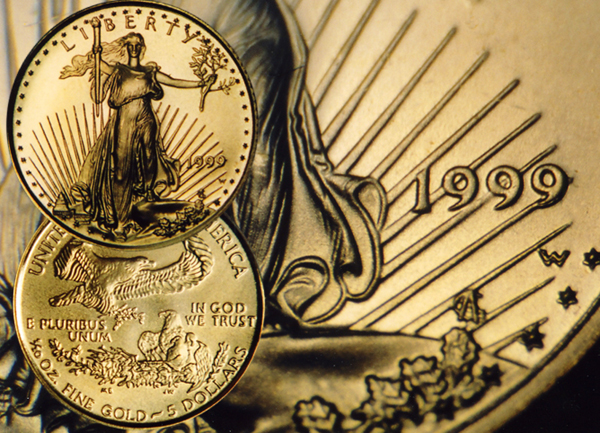


Ken Potter's Educational Series ...




Ken Potter's Educational Series ...

1999-W 1/10th Eagle $5.00 Gold Matte Finish
Error or Variety?
by Ken Potter - NLG
June 30, 2006

Photo © Ken Potter 2006
Some time ago a fellow sent in
an error-variety coin with some very interesting questions. He said:
"I have a 1999-W $5.00 Gold 1/10th Eagle that
was struck by the Mint with an Uncirculated Matte Finish instead of the intended
Proof finish for the West Point issue. Is this an error or variety -- the
grading service states it's an error?
Also, why is it referred to by the grading service as struck with
"Unfinished Proof Die" when the die has clearly been
"finished" albeit the wrong finish?
He made to very good points and I had to explain that it was
both an error and a variety and that the grading service was technically
wrong. My answer to him was as follows and aught to be of interest to
others.
According to Alan Herbert in his book, The Official Price
Guide To Mint Errors:
"Only a small fraction of the mint product is an "error." The E word was born back in the dark ages when almost nobody knew anything about the minting process. Today we know enough about the complexities of minting coins to be able to pinpoint the exact cause, or causes, in 99 percent of the cases. We desperately need the proper language to fit with that increased knowledge. Teaching novice collectors nicknames and slang is akin to teaching a chimp how to use a baseball bat. It curls my hair to hear professional people, engineers, doctors, lawyers and other college graduates misusing the language like they do.
We know that many actions by mint personnel are expedients-things done to speed up production, salvage worn or damaged dies, use up substandard
planchets, or just simply to save money. Obviously, an expedient is not an "error." It was done deliberately. Other mint products are different because of wear and tear to the dies, coin press, or other equipment. Again this stretches the definition of "error" to have to include a normal result of heavy usage.
The more we know about the minting process, the harder it is to stretch the E word to fit the end result. The simple solution is to have a "real" term which will include any and all variations, and-just as important-will include "errors," but in their proper perspective. That term is minting varieties.
A minting variety is, by definition, "A coin which is normal or which exhibits a variation of any kind from the normal, whether intentional, accidental, or due to wear and tear on the equipment, as a result of any portion of the minting process, whether at the blank or planchet stage, as a result of a change or modification of the die, or during the striking process."
Having been employed within a manufacturing environment for over 30 years
I can confirm Herbert's statements as being accurate. The fact is the
majority of items stated to be errors in our hobby most probably were not made in
error! Just like any other factory in the world, the Mint must knowingly
make
many of them as an expedient or for other logical reasons.
However,
on a more practical level I do realize that the term error is here to
stay, like it or not, and that the terms error and variety carry
certain connotations to many in the error-variety hobby. So, I will
not debate the pros and cons of the terms and in most cases on a commercial
level I will refer to those items most often referred to as errors as just that.
On a more scholarly level I recognize that most items termed
errors are not. Certainly minor changes in a die due to age and use such
as die chips, die dents, die breaks, clashes, die flow lines, etc., are no more
errors than age lines on a person's face. Another way of putting it
is: would you consider the effects of wear and tear on the tires on your
car resulting from driving it back and forth to work to be errors?
Nonetheless, there are differing opinions as to whether or not normal wear and
tear on a die should be considered an error when it is used to strike a perfectly
acceptable coin.
On the question of referring to your coin as struck with an
"unfinished proof die," you are correct in alluding to this being
incorrect terminology. The fact is the die was finished completely, so calling it unfinished is inaccurate.
The proper terminology would be "improperly finished proof die" or
something to that effect. It would be proper to elaborate further by
saying "... finished as a matte uncirculated die" or similar.
Related Articles:
Is
it an Error or a Variety?
States Quarter Die Chips, Etc. -- Errors Or Varieties?
##
For more information on this item click below:
Send email to: KPotter256@aol.com



Numismatist Since 1959 ~ Serving
the Collector Since 1973
CONECA's Longest Serving Doubled Die Attributer
Member of: ANA-LM CONECA-LM NLG NCADD-FM
MSNS-LM
NWDCC RCC WBCC BBCC IASAC
Unless otherwise stated, all Photographic Images are by Ken
Potter. Copyright Ken Potter, 1993, 1994, 1995, 1996, 1997, 1998, 1999, 2000, 2001,
2002. Use of images in any manner is strictly prohibited without the express written
permission of the copyright holder.
Free counters provided by Andale.